#Australidelphia
Text

A whole collection of Oceania marsupials! There are so many of these little creatures.
#australidelphia#bandicoot#tasmanian devil#thylacine#quoll#numbat#bilby#animals#species sketchpage#my art
50 notes
·
View notes
Text
It's #NationalAardvarkWeek! Besides being one of my favorite mammals, it's also the most evolutionarily distinct one (more on that below). Stay tuned for more aardvark art and info all week long! 😎 #AardvarksAareAawesome
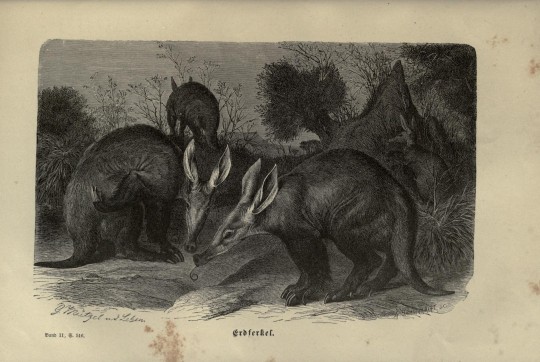
"Erdferkel," Plate 14 in Brehms thierleben, allgemeine kunde des thierreichs, 1876-9. Biodiversity Heritage Library.
#DYK the Aardvark (Orycteropus afer) is the only living representative of an entire ORDER of mammals, Tubulidentata? This helped it score as the #1 most evolutionarily distinctive (ED) mammal on ZSL's EDGE of Existence list:
[FYI the only other mammal order with a single living member is Microbiotheria, represented by the Monito del Monte (Dromiciops gliroides) - however they have more living relatives one step out in superorder Australidelphia than the Aardvark does in the Afrotheria.]
#aardvark#mammals#mammalogy#zoology#Tubulidentata#Microbiotheria#Monito del Monte#Australidelphia#Afrotheria#ZSL#EDGE of Existence#evolutionarily distinctive#illustration#book illustration#European art#German art#19th century art#lithograph#print#National Aardvark Week#Aardvarks Aare Aawesome#animals in art
3 notes
·
View notes
Text
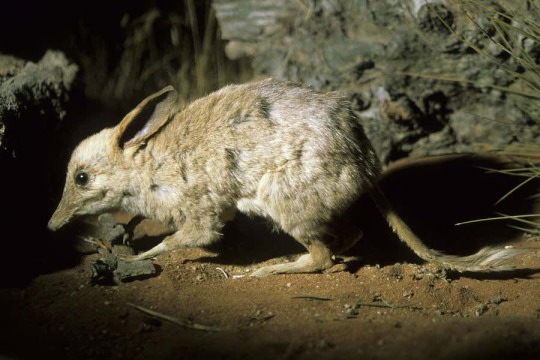
Chaeropus ecaudatus the Southern Pig–footed Bandicoot
Pig–footed bandicoots (genus Chaeropus) were so called because of their hooflike forefeet. They had relatively slender legs compared to other bandicoots, allowing them to move quickly through the landscape.
Although initially designated as a single species, Chaeropus yirratji was split from C. ecaudatus in 2019 on the basis of morphological differences. Both species became extinct by the 1950s due to habitat loss from land clearing for agriculture and predation from cats and foxes.
#southern pig–footed bandicoot#animals#australian animals#mammals#australian mammals#marsupials#australian marsupials#bandicoots#pig–footed bandicoot#s o: australidelphia#o: peramelemorphia#f: chaeropidae#g: chaeropus#sp: c. ecaudatus
32 notes
·
View notes
Text

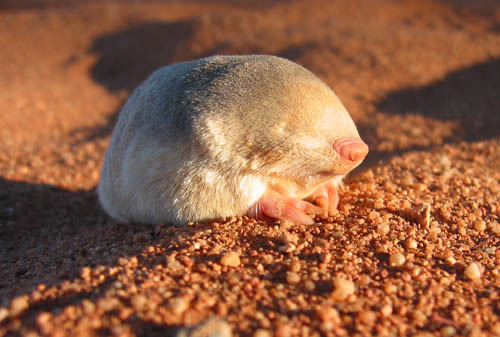
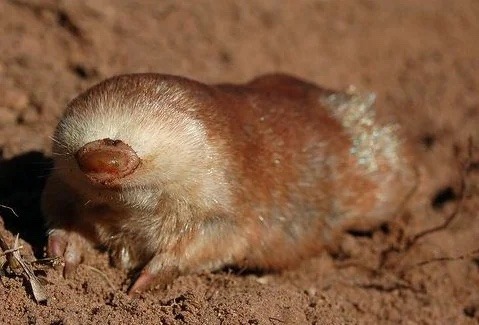
@sabertoothwalrus Now that people are interested in moles. These three moles are not related.
Top one is Laurasiatheria (same superorder as dogs, horses, bats, and hedgehogs)
Middle one is Afrotheria (same superorder as elephants, tenrecs, aardvarks, and manatees)
And the bottom one is Australidelphia (same superorder as cuscuses, quolls, bandicoots, and wallabies)
All three have convergently evolved to be moles! How cool is that!
3K notes
·
View notes
Text
So there’s possums and opossums right? Opossums are from the Americas, members of Ameridelphia which includes every marsupial in America, and possums are from Australia (and some surrounding area) and members of Australidelphia, which includes every marsupial in Australia.
So American Opposums look like this

And then somebody named this thing a possum because it looks like the American one:

I mean it doesn’t, but ok, it has a pouch, it has opposable thumbs, close enough. Even though opossum comes from a Proto-Algonqian word meaning “white dog or dog-like beast” and this thing is like...sort of yellow? Whatever, not the point of this post.
The point of the post is this thing

This thing is a Colocolo Opossum. It lives in Argentina and Chile, and it was named that because it looks like the eastern pygmy possum from Australia. So it lives in America, but was named for the Australian possum, but it was named Opossum, which are the American ones?
Oh yeah, it also has a pouch, and opposable thumbs, and is a marsupial, so it’s related to...which one? Well it lives in America, it’s named Opossum, it’s clearly part of Ameridelphia right? Related to the other American Opossums? Nope. It’s closer to the Australian ones, it’s part of Australidelphia.
In fact, it’s the only marsupial in America that is not part of Ameridelphia, and the only marsupial that’s part of Australidelphia not native to Australia.
Now you might notice a problem here if you know about planet earth, and that’s that Australia and South America are pretty far from each other. Like over 10,000 kilometers? So how did this little guy cross the pacific?

So this is Cenozoic earth, the period we’re interested in is about 55 million years ago, when the first marsupial emerges. South America and Australia are connected by land via Antarctica. The thought was that maybe this guy walked from Australia to South America sometime 48 million years ago.
In 2010 they found out....they didn’t. They did some analysis of their DNA and found out that, yes, it is part of Australidelphia. It is also the most basal of that superorder though. It didn’t come to South America from Australia...every other Australian Marsupial came to Australia from South America, and they left this little dude behind.

So up there at the top is the American opossums, towards the bottom is all the Australian marsupials, our little friend here is the only one left in the order Microbiotheres.
This little guy is...sort of the bridge between American Opossums and Australian Possums.

4 notes
·
View notes
Photo
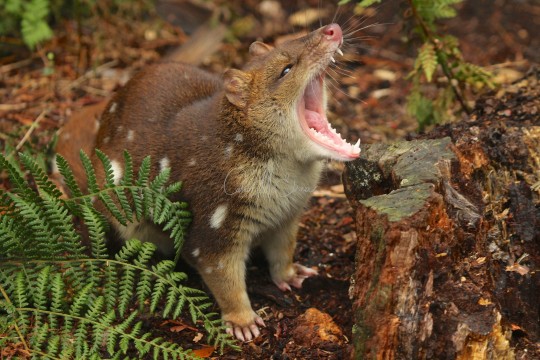
Spotted-tail quoll (Dasyurus maculatus)
Photo by Caleb McElrea
#spotted tail quoll#tiger quoll#quoll#dasyurus maculatus#dasyurus#dasyurini#dasyurinae#dasyuridae#dasyuromorphia#australidelphia#marsupialia#metatheria#mammalia#tetrapoda#vertebrata#chordata
859 notes
·
View notes
Text
†Pig-footed Bandicoots (Chaeropus)
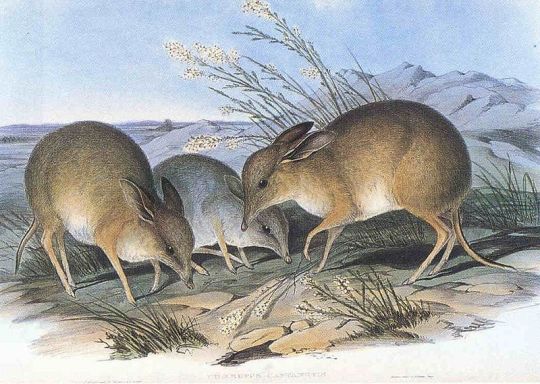
Pig-footed bandicoots were recently considered separate to all other bandicoots. Two similar species are recognized, varying in historical ranges and morphology of dentition and feet. Their fur ranged from uniform grey-brown to russet and fawn tones, helping them camouflage into arid sandy desert and grassland. From 32 to 40cms long, they measured up similarly to a small rabbit.
Chaeropus, uniquely, had feet like tiny hooves. They walked on only two functional toes of the forefeet, and one toe of the hind-foot, the rest being vestigial. They were known to run very fast, with a quick bounding gait. Though reported to eat insects, it’s thought they were largely herbivorous.
The Southern pig-footed bandicoot, C. ecaudatus, occurred through desert shrub-lands in the lower part of South Australia extending into Western Australia. C. yirratji, the Northern pig-footed bandicoot, inhabited grassland and sandy desert in central Australia and WA.
Both species were never prolific according to Indigenous oral tradition. However, they were in serious decline by the 19th century and were extinct less than 150 years after European description. Foxes were not yet established in their ranges, and though some cats were, the cessation of thousands of years traditional burning practices is thought to have been the major contributor to their extinction. Burning provided a patchwork of new growth on which to feed alongside recovered zones of shelter. Introduction of sheep and cattle also changed the landscape dramatically, further decimating crucial food sources of native animals.
#Chaeropus#pig-footed bandicoot#Chaeropodidae#Southern pig-footed bandicoot#Northern pig-footed bandicoot#Chaeropus ecaudatus#Chaeropus yirratji#Peramelemorphia#marsupials#australian animals#australian wildlife#Australidelphia#extinction
57 notes
·
View notes
Text
That's right, kangaroos are left-handed
By Will Dunham WASHINGTON (Reuters) - Research on wild kangaroos in Australia is challenging the notion that having a strong hand preference is a trait that developed primarily in people and other primates. Scientists said on Thursday that these Australian marsupials displayed a natural preference for using their left hand for feeding, self-grooming and other activities. "We found a pronounced degree of 'handedness,' comparable to that in our species," said biologist Yegor Malashichev of Saint Petersburg State University in Russia. http://dlvr.it/BGyMNz
0 notes
Text

Side view of skull of Thylacoleo carnifex. From On the fossil mammals of Australia. - Part II. Description of an almost entire skull of the Thylacoleo carnifex, Owen, from a freshwater deposit, Darling Downs, Queensland
#thylacoleo carnifex#animals#mammals#marsupials#thylacoleo#s o: australidelphia#o: diprotodontia#s o: vombatiformes#f: thylacoleonidae#g: thylacoleo#sp: t. carnifex#palaeontology
31 notes
·
View notes
Text

Bandicoots in the genus Isoodon: Golden Bandicoot I. auratus; Northern Brown Bandicoot I. macrourus; Southern Brown Bandicoot I. obesulus.
From Menkhorst and Knight (2001) 'A Field Guide to the Mammals of Australia'
#animals#australian animals#mammals#australian mammals#marsupials#australian marsupials#bandicoots#golden bandicoot#northern brown bandicoot#southern brown bandicoot#s o: australidelphia#o: peramelemorphia#f: peramelidae#s f: peramelinae#g: isoodon#sp: i. auratus#sp: i. macrourus#sp: i. obesulus
1 note
·
View note
Text

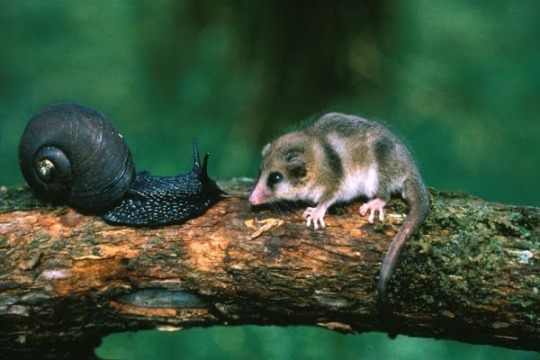


Monito del monte
Dromiciops gliroides
Family microbiotheriidae (only monito del monte still extant), order microbiotheria (only monito del monte still extant), superorder australidelphia (around 3/4 of marsupials. The Australian ones. From the Americas, only monito del monte still extant)
Very recently either one or two more species in its genus have been discovered. I’m gonna focus on this guy though.
Monito del monte is what a lot of people call a living fossil. This term is stupid though as it gives creationists hope that evolution is a hoax. “Living fossils” still evolve over time, just slower and in less noticeable ways.
The lineage of monito del monte is the most basal of the australidelphian superorder. The other two most basal marsupial groups to all of marsupials, not just australidelphians are the two opossum orders. That’s right! Two of em! Didelphimorphia (probably the first to branch), and paucituberculata.
So monito del monte was thought for the longest time to be a type of opossum, but they’re not opossums at all! Any physical similarities is convergent evolution baybee!
These guys live in spherical nests up in trees. They make the nests out of water resistant colihue leaves lines with moss or grass for insulation and camouflage (Colihue is a type of frost tolerant bamboo). They either live in pairs during the breeding season or year round. Not sure.
They also hibernate during winter! The base of the tail will swell with fat beforehand and their hearts slow from 230 bpm to under 30 bpm.
They mostly eat small invertebrates, but they like fruit. Especially mistletoe fruit.
ONLY NON OPOSSUM MARSUPIAL IN THE AMERICAS!!!!
@jackalspine @fifiibibii
11 notes
·
View notes
Text

Kowari (Dasyuroides byrnei)
Photo by charliejb
#captive animal#kowari#dasyuroides byrnei#dasyuroides#dasyurini#dasyurinae#dasyuridae#dasyuromorphia#australidelphia#marsupialia#metatheria#mammalia#tetrapoda#vertebrata#chordata
169 notes
·
View notes
Text
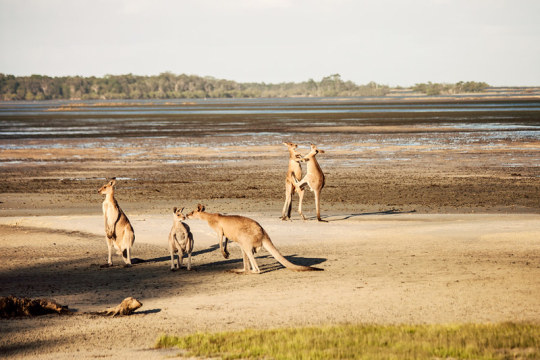
Eastern grey kangaroo (Macropus giganteus)
Photo by Roz Bannan
#id'ing#eastern grey kangaroo#macropus giganteus#macropus#macropodinae#macropodidae#macropodoidea#macropodiformes#diprodontia#australidelphia#marsupialia#metatheria#mammalia#tetrapoda#vertebrata#chordata
47 notes
·
View notes
Photo
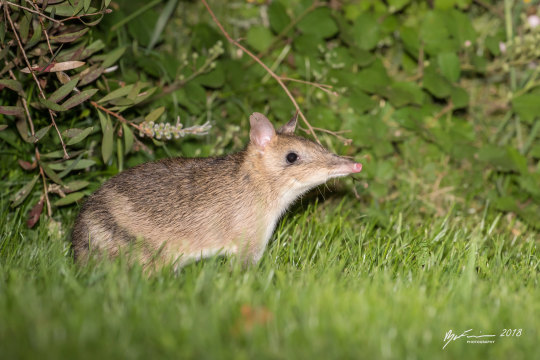
Eastern barred bandicoot (Perameles gunnii)
Photo by Ryan Francis
#eastern barred bandicoot#bandicoot#perameles gunnii#perameles#peramelinae#peramelidae#peramelemorphia#australidelphia#marsupialia#metatheria#mammalia#tetrapoda#vertebrata#chordata
115 notes
·
View notes
Text
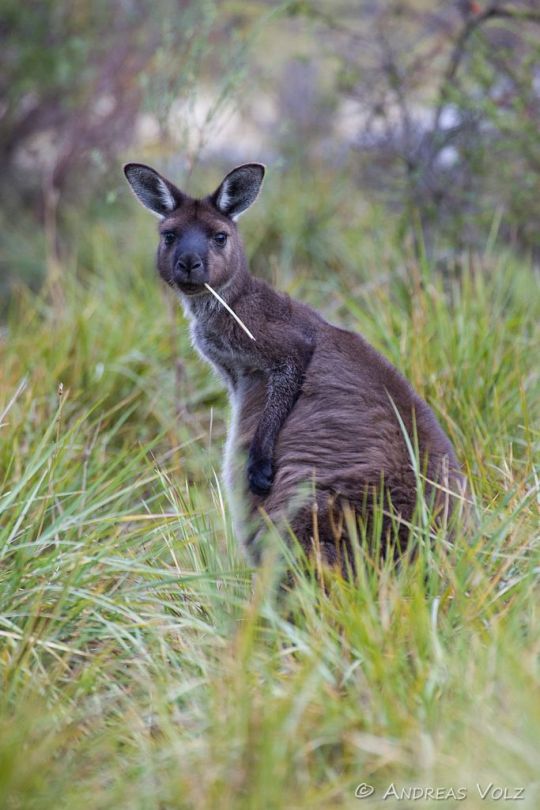
Western grey kangaroo (Macropus fuliginosus)
Photo by Andreas Volz
#western grey kangaroo#macropus fuliginosus#macropus#macropodinae#macropodidae#macropodoidea#macropodiformes#diprodontia#australidelphia#marsupialia#metatheria#mammalia#tetrapoda#vertebrata#chordata
31 notes
·
View notes
Photo
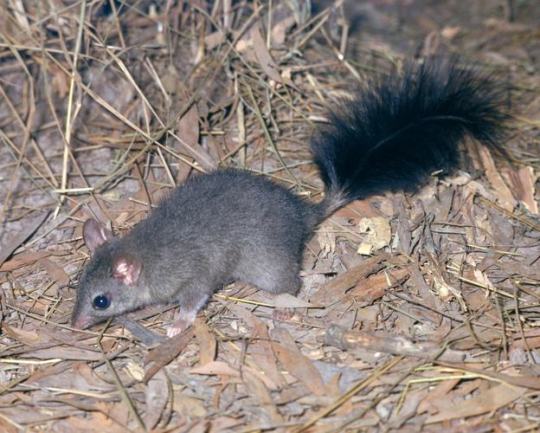
Common wambenger (Phascogale tapoatafa)
Photo by Ken Stepnell
#common wambenger#wambenger#tuan#brush tailed phascogale#phascogale tapoatafa#phascogale#phascogalini#dasyurinae#dasyuridae#dasyuromorphia#australidelphia#marsupialia#metatheria#mammalia#tetrapoda#vertebrata#chordata
51 notes
·
View notes